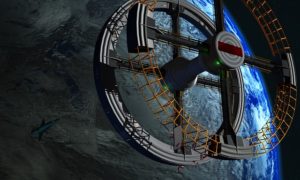Cross-Laminated Timber
Or: Wood You?

Laminated
Wooden buildings are making a comeback, and in a big way. Well, make that a sort-of wood. We create cross-laminated timber (CLT) by gluing layers of parallel beams atop one another perpendicularly, forming panels that are up to six inches thick.
The panels are as comparably strong as steel. Much of this strength comes from their ability to distribute loads across the entire panel, rather than the skeletal columns used in steel constructions.
It's essentially plywood on steroids. A lot of steroids.
This isn't just an experimental material. We developed CLT in the 1990s. We’ve already used it to build multiple nine- and ten-story buildings, and we have towers up to 34 stories in the works. (Old wooden buildings were lucky to reach five stories in height.)
Their internal architecture doesn't resemble old wooden buildings, though. The design is much more similar to concrete buildings.
And the process moves considerably faster than conventional steel and concrete construction—as much as 30 percent faster than comparable buildings, and 15 percent cheaper. Much of the savings in time come from the fact that panels are usually prefabbed, and just need to be screwed together.
Fire safety is one of the usual concerns regarding building with wood, but it's not one with CLT. Yes, the timber on the outside will char, but the inside will still remain structurally sound. Steel, on the other hand, melts all the way through when it gets hot enough.
Designers and builders are not leaving things to chance, though: they usually install gypsum paneling over the CLT to further shield it from fire.
CLT is also considerably more environmentally friendly. Wood is a carbon sink—which means it absorbs more carbon than it emits as carbon dioxide. So buildings that we construct from wood serve to offset carbon emissions to the point where the building is carbon negative.
Which means that treehouses and wooden skyscrapers are actually fighting global warming.
_________
Quotable
To The Yard Ramp Guy: Would you dare quote about wood this week?
“Ultimately, literature is nothing but carpentry. With both you are working with reality, a material just as hard as wood."
— Gabriel García Márquez
Enter the Octobot
Squishy Robotics

The Octobot
When someone talks about robots, the first thing you think of is metal. Metal limbs, gears, motors, etc. Maybe there’s a bit of plastic involved, but the basic nature of a robot is something solid, rigid, unyielding.
Even robots built to look human in fiction—androids—generally have rigid infrastructure underneath their fleshy bits. The thing is, though: none of those elements are actual requirements of robothood.
The Octobot is the first entirely soft-bodied robot in existence. This 3D-printed robot is constructed entirely without electronics or circuitry and instead relies on pneumatic logic gates. Tiny channels, grown into the material of the bot during printing, carry hydrogen peroxide throughout the body, passing through various gates and coming into contact with bits of platinum, which break down the hydrogen peroxide.
The released oxygen gas then expands and propels, moving the limbs. The current model can run for about eight minutes on a full tank.

Semi-autonomous behavior
Current designs can’t do much more than wiggle around, but future Octobot designs promise the ability to move around and interact with their environments more fully.
How are these soft-bodied robots going to be used, though? We need to look to the Octobot’s inspiration for that.
Like the octopus, soft-bodied robots would possess the ability to force themselves into much smaller spaces and conditions than a normal, rigid robot.
The lack of an absolute requirement for an electrical system or a chemical power source might also present an advantage in certain conditions, though I’m sure many—if not most—future soft robots will have electrical systems and computers.
Plus, soft robots would just be fun to play with.
_________
Quotable
Dear Yard Ramp Guy: Danger, Will Robinson! Danger!
“The danger of the past was that men became slaves. The danger of the future is that men may become robots."
— Erich Fromm
Debunking Hollywood Science
Or: Nope. Just Nope.
 Seems that bad movie science is something we just have to live with. It's as if the writers spent thousands of hours, over years and years, learning to write instead of becoming scientists.
Seems that bad movie science is something we just have to live with. It's as if the writers spent thousands of hours, over years and years, learning to write instead of becoming scientists.
We can't forget the contributions of novelists, comic book writers, and videogame creators, but the film writers are the most visible ones.
A few of my favorites:
- Acid will dissolve solid objects: Not usually, no. Most acids are relatively weak and get used up as they react. There are “superacids” that do behave somewhat like movie acids, but they're so dangerous that we can't actually store them in anything except Teflon. And even superacids don't eat through metal as fast as movie acid (though fluoroantimonic acid comes close). Of course, if you're talking about eating through sponge or a person, that's another matter.
- Volcanoes can erupt at a moment's notice: Well, sure, if by “a moment's notice” you mean a matter of months. Scientists are getting pretty good at predicting eruptions—not to the point of pinning it down to a specific day or time, but they can usually give you a heads up that something is likely to happen weeks or months ahead. Also, a volcano definitely WON'T be forming in Los Angeles any time soon.
- Magic cures: Vaccines generally take years to develop. One guy certainly can't cook one up in a few hours.
- Diamond swords: Diamond may be the hardest naturally occurring material on Earth (other than Lonsdaleite, which is basically a diamond variant), but this does NOT mean that diamond would make a good material for a sword. While it is hard, diamond is also incredibly brittle and would probably break the first time you hit anything with it.
- Literally anything involving computer hackers: Hollywood hasn't the foggiest idea how computers work, far as I can tell.
- Movie fires are all smokeless: In real life, fires in an enclosed space produce so much smoke that you can't see a thing. Even a small fire in an oven will blind you completely with the smoke. Trust me on that one.
- Planets that only have one climate: Wouldn't actually work in real life. A planet with an atmosphere will always have different climates. There's an enormous list of reasons why, ranging from the obvious (temperature variations by latitude) to the obscure (lack of sufficient oxygen production in certain biomes, like deserts, to maintain a breathable atmosphere).
- Lasers that move at visible speeds: Nope. Just nope.
_________
Quotable
Oh, Yard Ramp Guy...are you star struck?
“When the legend becomes fact, print the legend.”
— from “The Man Who Shot Liberty Valance”
Surviving Absurdity
Or: How to Make a $1,500 Sandwich

Thinking 'bout making a rich sandwich
Have you ever made food from scratch? If you said yes, you're probably thinking of cooking bread from flour and yeast and so on.
You probably aren't thinking of growing the wheat, harvesting it, milling it, and all that jazz. One guy in Minnesota, however, decided to actually cook a chicken sandwich from scratch. It took him six months and cost him $1,500.
Little bit ridiculous, right? We’ve evolved our modern society toward specialization in order to reduce the workload on people and prevent us from having to do such outrageous things.
The most interesting aspect of this is, of course, the salt: the guy from Minnesota had to fly to the West Coast to harvest his salt. If he wanted to be a purist, he would have needed to either walk all the way to the ocean or build his own airplane from scratch.
Obviously, that’s too much work for a YouTube video.
If he wanted to be even more of a purist, he would have needed to build all his tools himself. No stove; rather, an open fire. And no metal pot; he would have needed to fashion his own cookware instead. You can see how quick the absurdity things would’ve gotten.
So where am I going with all this?

I made me a sandwich…for $3.45
Believe it or not, I wanted to talk about survivalists. The typical survivalist strategy is to master a certain number of survival skills and to accumulate massive amounts of resources for survival purposes.
The missing ingredients? Almost everything, really. Our society has accumulated unbelievably huge quantities of knowledge dedicated toward merely keeping civilization running, mostly in the form of working professionals.
If someone were to make all of society's doctors disappear, we wouldn't be able to just set a bunch of people to the books and expect them to become doctors in a decade or so. Civilization reconstruction is a problem of a magnitude more significant than assembling a sandwich from scratch.
Any society emerging from survivalists in the wake of the collapse of civilization is going to be fairly primitive, by necessity.
And just to reassure Maggie and the kids and my gaggle of grandkids: I'm not investing in survivalist gear. Modern civilization is pretty durable. Gambling on it failing seems like way too much of a sucker bet to me.
_________
Quotable
Hey, Yard Ramp Guy: you might want to put one of your loading docks in a safe bunker, just in case…
“The ultimate value of life depends upon awareness and the power of contemplation rather than upon mere survival.”
— Aristotle





